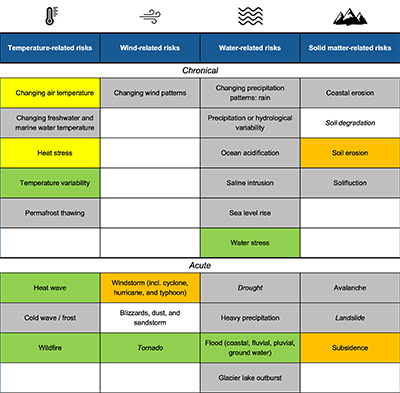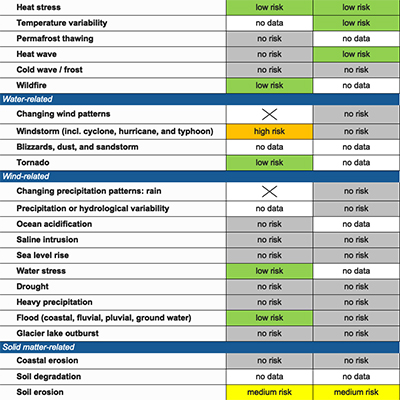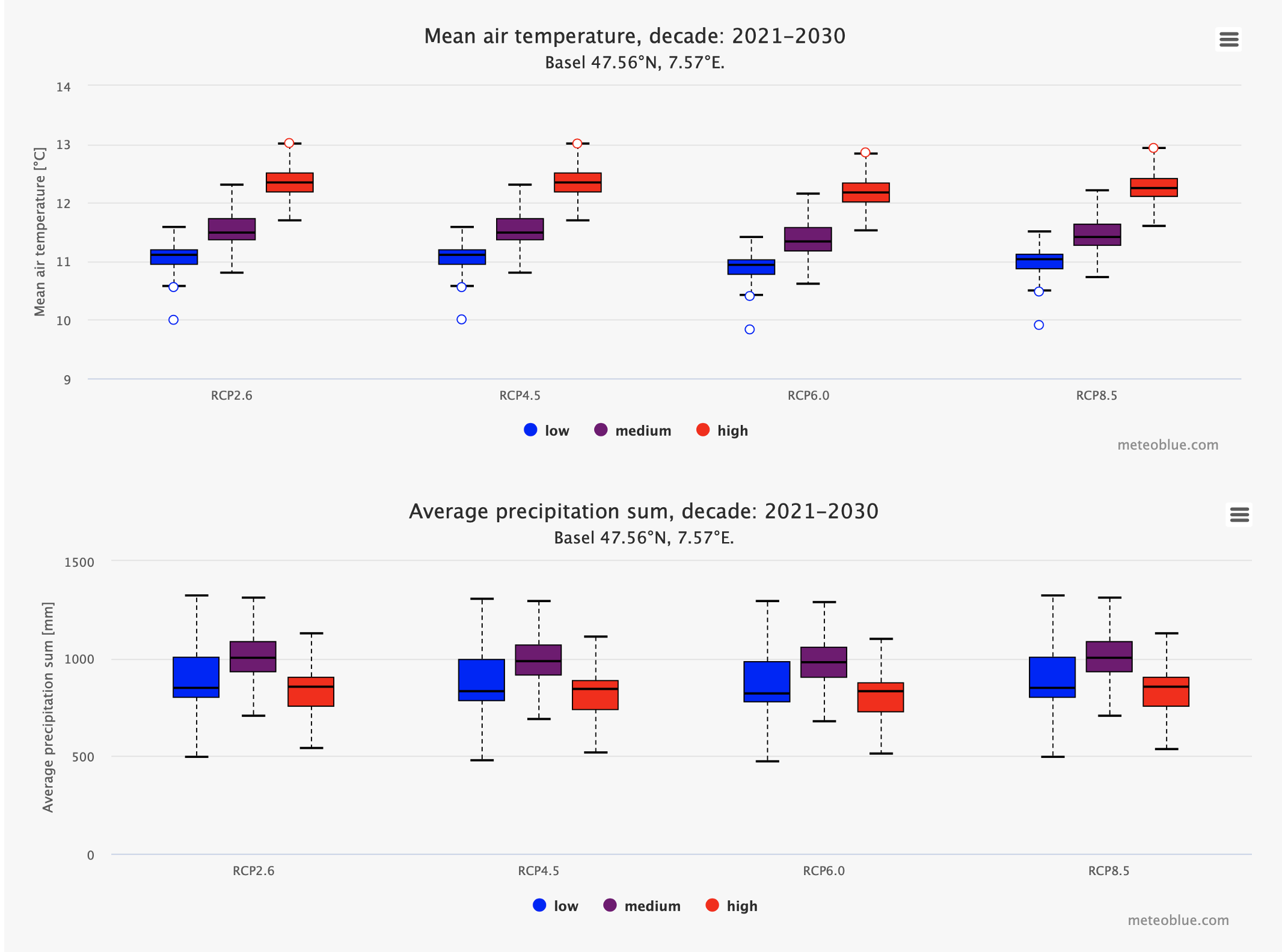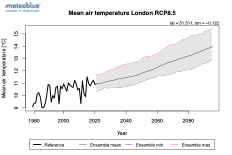More and more countries are adopting laws that require companies to report on the sustainability of their enterprise as part of general ESG (Environmental, Social, Governance) reporting, such as the IFRS (International Financial Reporting Standards), or other directives.

The EU in particular has introduced a directive for companies to report their sustainability. The CSRD (Corporate Sustainability Reporting Directive) obliges many companies to provide ESG reporting, which in turn necessitates the companies' gathering of the required data. The associated ESRS (European Sustainability Reporting Standards) and the EU Taxonomy for Sustainable Activities also require an assessment for physical climate risks.
meteoblue offers a solution for physical climate risk assessment which is optimised for regulatory purposes, such as the EU Taxonomy and CSRD. The meteoblue Climate Risk Assessment Report has successfully passed audits by the leading global accounting firms.
Why use our Climate Risk Assessment Reports for your sustainability reporting?
-
Safeguard your business model
Analyse the potential climate risks to your business model. -
Securing assets and investments
Take adaptation measures based on the state-of-the-art data basis -
Benefit from our expertise in climate risk
Verified through successful audits by the leading accounting firms and use by many large companies for EU taxonomy, CSRD and CDP -
Fulfil requirements from international frameworks (e.g. CSRD, EU-Taxonomy)
meteoblue is orientated to the regulatory requirements and works closely with partners to ensure that the reports are compliant

5% of the revenue will be reinvested into climate change mitigation projects
Product features
- Available for any location worldwide
- Location-specific assessment
- Based on EU Taxonomy Annex A
- Coverage of all common RCP (Representative Concentration Pathways) and SSP (Shared Socioeconomic Pathway) scenarios
- Climate projections up to 2100
- Detailed technical documentation
- Separation between the current risk and future risk
- State-of-the-art technology: same data sets as in the last report by the Intergovernmental Panel on Climate Change (IPCC)
Easy access: How to get a climate risk assessment for your location
Please send us an email with the following information:
- Type of report (EU Taxonomy or CDP)
- Coordinates of the location
- Future time period (min. 10 and max. 30 years in period between 2030 - 2100)
- Company name
meteoblue translates complex data into easy and understandable results

EU Taxonomy Report - Designed to fulfil the requirements in the EU Taxonomy
The EU Taxonomy Report covers the requirements of the EU Taxonomy: the risk classification of the 29 climate hazards according to the latest state of the technology. Requirements of the CSRD and thus the ESRS can therefore be fulfilled.
You will receive:
- Product presentation in a separate meeting if desired
- Detailed 50 pages technical documentation in PDF format
- Detailed 40 pages EU Taxonomy Report in PDF format
- Overview of all analysed locations as CSV
- Support for follow-up questions
This package is optimised to meet the strict regulatory requirements. A reliable technical documentation is the basis for a successful audit. If the auditor has any further questions about our climate risk analysis, we will be glad to assist you.

CDP Report - Designed to fulfil the requirements of the CDP
The CDP Report is optimised for requirements of the CDP (Carbon Disclosure Project) reporting and includes a 15 pages report. The data analysis is based on the worst-case emission scenario RCP8.5 (Representative Concentration Pathway).
The CDP framework is a voluntary framework and less comprehensive than the EU taxonomy. Three climate risks (heat, flood, wildfire) are assessed for the emission scenario RCP8.5
Selected partner

We are a proud partner of sustainable AG
sustainable AG is one of the leading consulting companies in Germany in the field of sustainability.
Together we developed a climate risk assessment solution that is now being used by many companies.
EU Taxonomy Report in focus
Climate change means a shift, but these can take different forms. meteoblue decodes the uncertainty:

Risk Classification - Scientific approach to classify climate risks
meteoblue classifies 29 risks in five different risk classes for a clear overview. You have to act in the event of a red flag! Our report provides a reliable answer as to whether action should be taken.

Current and future risk - The difference between today and the future
The EU Taxonomy report shows the current and future climate risks in order to provide a clear picture of climate change. This makes it easier to visualise a potentially increasing risk!

Detailed scientific background information - Risk value described in an easy non-technical language
For an accurate assessment, it is important to have a solid database. The report not only contains the risk classification of the required climate hazards, but also provides important background data which is presented in tables and figures and are easy to understand for everyone.
Further related climate change analysis tools
meteoblue offers other products and services that enable you to visualise climate change locally so that you can make the best possible business decisions.

climate+ Instant access to climate risk assessment data
climate+ provides climate prediction and risk assessment data, ideal for compliance with EU taxonomy. Access temperature and precipitation data for IPCC's four RCP scenarios (2.6, 4.5, 6.0, 8.5) at any global location, with hourly resolution up to year 2100.
- Climate prediction data until the end of the 21st century
- All RCP scenarios by IPCC included
- Uncertainty assessment
- Global data availability
- Multiple formats available
- Free monthly webinars

Climate data & Visuals Understand the arising risks of climate change for any location on Earth
Climate data & Visuals shows the past and most likely future development of more than 20 variables, including air temperature, precipitation amount and wind speed based on simulation data from the IPCC report.
Why you should choose meteoblue

With meteoblue as a reliable partner for your climate risk assessments, your compliance with EU regulations is ensured. Please contact me for a quote or more information.
Edgar Caspar
International Marketing Specialist






